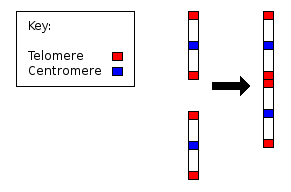Variation in chromosome count (ploidy) is impossible in evolution. One member of a species with 2 sets of chromosomes cannot mate with a member with 4. Thus, for the chromosome count of a species to change (and thus account for the variety of counts in nature) a vast portion of a species would have to evolve a new chromosome set simultaneously.
from Wikipedia
On the surface, this could seem like a legitimate argument. But as always, we must look a little deeper to see their errors. We should know that chromosomes package the information of DNA which help pass our genes from one generation to the next. In humans, your mom and dad each gave you 23 chromosomes to give you a total of 46. Each species has a specific number of chromosomes. Dogs have 78, garden peas have 14, and the Adder's Tongue Fern carries 1,260 chromosomes.
Mistakes in the number of chromosomes (polyploidy) usually prove lethal or at least cause many problems for the offspring. Children with Down Syndrome are born with 47 chromosomes while other disorders have similar number mistakes. The point being, in order to accurately pass on our species information you need the correct number of chromosomes.
From an evolutionary perspective, closely related species tend to have the same number of chromosomes. All of the Great Apes have 48 chromosomes in their cells. Except for one, humans. We only have 46, yet we are consistently groups with chimpanzees, gorillas, and orangs. Since we know we couldn't just lose two whole chromosomes or we would die, something must have happened. And it did.
The idea was simple. Two small ape chromosomes must have stuck together to make a larger human chromosome. This way, no information gets lost but we still "lose" a chromosome. We confirmed this by analyzing human and chimp chromosomes. Chromosomes come with two special non-coding regions. Telomeres act as caps on the end of a chromosome (like the aglets on your shoelaces) and the centromeres show up in the middle for the processes of mitosis or meiosis. A normal chromosome would have two telomeres and one centromere, while our hypothetical conjoined chromosome would have 4 telomeres and 2 centromeres.
When scientists scoured our blueprints, they found the Chromosome #2 fit the bill. That chromosome has four telomeric regions, one active centromere and one inactivated centromere. Later, scientists discovered the two ape chromosomes which came together. Human Chromosome #2 contained all of the matching genes in the two smaller ape chromosomes. So at some point after the human lineage split from the chimpanzees, the chromosomes combined and became the second largest chromosome in our cells. Mystery solved!
Chromosomes do carry incredibly important information. Losing whole chromosomes can cause serious consequences. Yet, they act as any genetic material. Chromosomes (or parts of chromosomes) can be duplicated, deleted, inverted, or translocated. These chromosomal mutations play a huge role in the evolution of species and provide excellent evidence to counter the ridiculous claims of Conservapedia!
The idea was simple. Two small ape chromosomes must have stuck together to make a larger human chromosome. This way, no information gets lost but we still "lose" a chromosome. We confirmed this by analyzing human and chimp chromosomes. Chromosomes come with two special non-coding regions. Telomeres act as caps on the end of a chromosome (like the aglets on your shoelaces) and the centromeres show up in the middle for the processes of mitosis or meiosis. A normal chromosome would have two telomeres and one centromere, while our hypothetical conjoined chromosome would have 4 telomeres and 2 centromeres.
 |
| from Wikipedia |
When scientists scoured our blueprints, they found the Chromosome #2 fit the bill. That chromosome has four telomeric regions, one active centromere and one inactivated centromere. Later, scientists discovered the two ape chromosomes which came together. Human Chromosome #2 contained all of the matching genes in the two smaller ape chromosomes. So at some point after the human lineage split from the chimpanzees, the chromosomes combined and became the second largest chromosome in our cells. Mystery solved!
Chromosomes do carry incredibly important information. Losing whole chromosomes can cause serious consequences. Yet, they act as any genetic material. Chromosomes (or parts of chromosomes) can be duplicated, deleted, inverted, or translocated. These chromosomal mutations play a huge role in the evolution of species and provide excellent evidence to counter the ridiculous claims of Conservapedia!

No comments:
Post a Comment